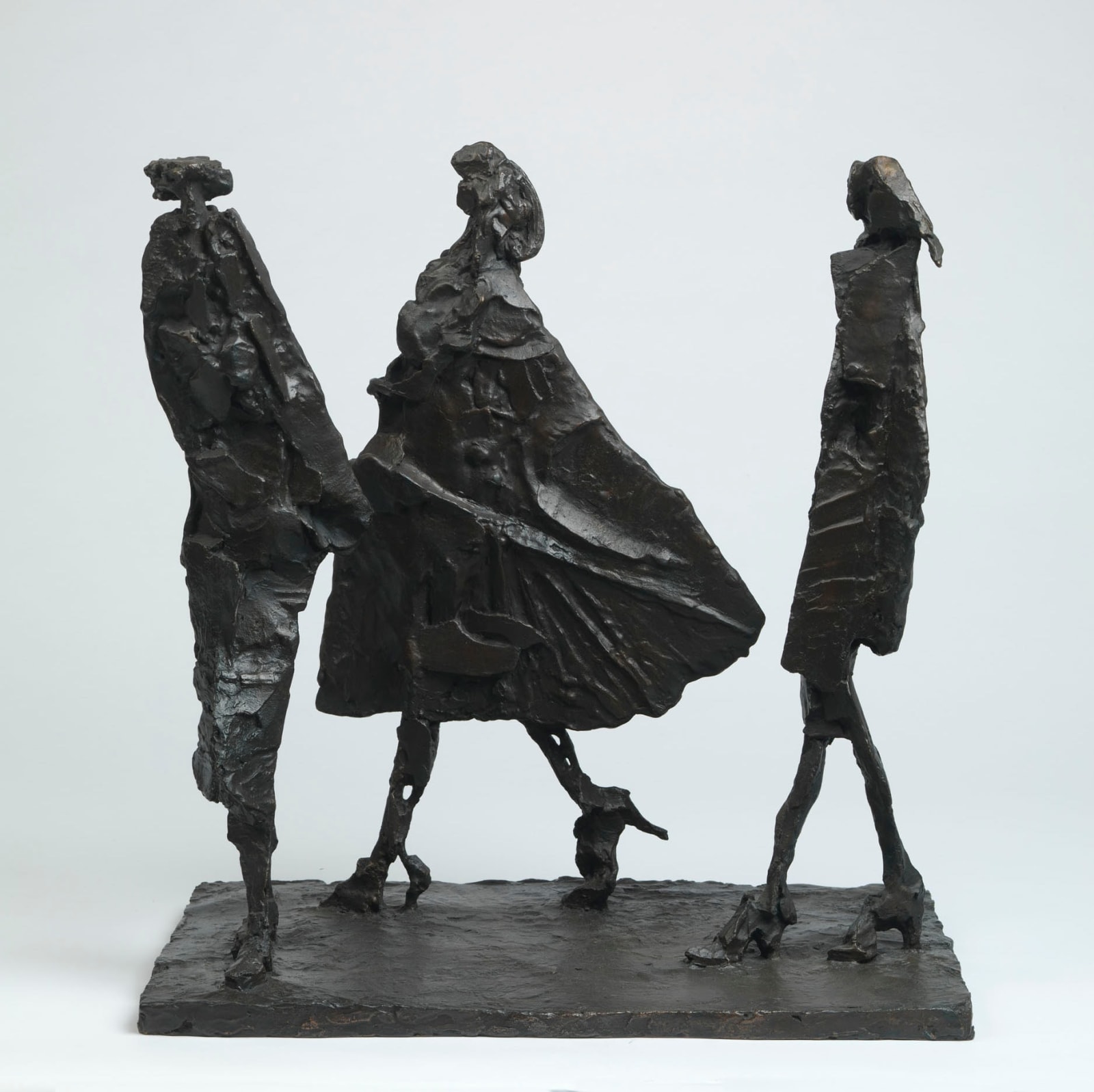George Fullard British, 1923-1973
Three Women, 1958
Bronze
65 x 54.5 x 33 cm
25 5/8 x 21 1/2 x 13 in
25 5/8 x 21 1/2 x 13 in
Only known cast
Fullard's Three Women is a classic example of the artist's work from the 1950s which focused mainly on the human figure with women being prominent, particularly mothers with young children...
Fullard's Three Women is a classic example of the artist's work from the 1950s which focused mainly on the human figure with women being prominent, particularly mothers with young children or babies. Here, three women stride with purpose in-front of their onlookers towards their destination. The motion of movement within this piece is further emphasised by the distressed surface of the bronze which, although a signature style of working in the material post-war, could be interpreted as a harsh wind which the figures battle against on their journey.
George Fullard was born in Sheffield and grew up in a Northern working class mining family with a background of left-wing politics. He studied at the Sheffield College of Arts and Crafts and went on to the Royal College of Art. He later became a lecturer at the Royal College and at the time of his death was Head of Chelsea School of Art.
During the Second World War he served in the army where he suffered severe injuries and narrowly escaped death when his tank was blown up in the prolonged battle for Monte Cassino. He was left severely wounded and with permanent scars on his head and shoulder. The experience of war became a central theme in his work as is particularly evident in later drawings and assemblages which explore images and ideas from that traumatic period. His drawings and sculpture that focus on themes of walking, falling and running figures allude directly to his experiences and particularly the terrifying blitzkrieg on Sheffield in 1940 which he witnessed.
Alongside his expressionist approach to modelling Fullard also used the idiom of assemblage to deal with the topic of war. He preferred to call himself an ‘image maker’ rather than a sculptor and particularly enjoyed the surprising juxtapositions that resulted from assembling disparate objects saying:
'It is that element of the unplanned which seem to have most point for me - the conscious effort of a complex production in order to produce the unforeseen. This is the basis of work - to plan and produce around a conscious ‘idea’ or subject really in order to permit the entry of the unexpected...'
Today Fullard’s work can be found in a number of private and public collections, including the Arts Council of Great Britain, Leeds City Art Galleries, Sheffield Galleries and Museums and the Tate Collection, London. Several bronze sculptures are on permanent public display in Sheffield City Centre.
George Fullard was born in Sheffield and grew up in a Northern working class mining family with a background of left-wing politics. He studied at the Sheffield College of Arts and Crafts and went on to the Royal College of Art. He later became a lecturer at the Royal College and at the time of his death was Head of Chelsea School of Art.
During the Second World War he served in the army where he suffered severe injuries and narrowly escaped death when his tank was blown up in the prolonged battle for Monte Cassino. He was left severely wounded and with permanent scars on his head and shoulder. The experience of war became a central theme in his work as is particularly evident in later drawings and assemblages which explore images and ideas from that traumatic period. His drawings and sculpture that focus on themes of walking, falling and running figures allude directly to his experiences and particularly the terrifying blitzkrieg on Sheffield in 1940 which he witnessed.
Alongside his expressionist approach to modelling Fullard also used the idiom of assemblage to deal with the topic of war. He preferred to call himself an ‘image maker’ rather than a sculptor and particularly enjoyed the surprising juxtapositions that resulted from assembling disparate objects saying:
'It is that element of the unplanned which seem to have most point for me - the conscious effort of a complex production in order to produce the unforeseen. This is the basis of work - to plan and produce around a conscious ‘idea’ or subject really in order to permit the entry of the unexpected...'
Today Fullard’s work can be found in a number of private and public collections, including the Arts Council of Great Britain, Leeds City Art Galleries, Sheffield Galleries and Museums and the Tate Collection, London. Several bronze sculptures are on permanent public display in Sheffield City Centre.
Provenance
From the artist's estate.Exhibitions
George Fullard: Sculpture & Survival, 2016Literature
George Fullard: Sculpture & Survival, 2016, Michael BirdPublications
George Fullard: Sculpture & Survival, 2016, Michael BirdJoin our mailing list
* denotes required fields
We will process the personal data you have supplied in accordance with our privacy policy (available on request). You can unsubscribe or change your preferences at any time by clicking the link in our emails.
